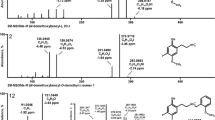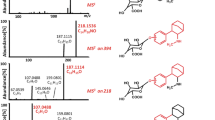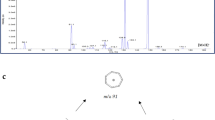Abstract
4-EA-NBOMe (N-(2-methoxybenzyl)-4-ethylamphetamine, 1-(4-ethylphenyl-)-N-[(2-methoxyphenyl)methyl]propane-2-amine) is an amphetamine-derived new psychoactive substance (NPS) of the N-methoxybenzyl (NBOMe) group first seized by German custom authorities. In contrast to the phenethylamine NBOMes, studies on the pharmacological, toxicological, or metabolic properties are not yet published. The aims of the presented work were the use of LC-HR-MS/MS for identification of the phase I and II metabolites of 4-EA-NBOMe in rat urine and pooled human S9 fraction (pS9) incubations, to compare metabolite formation in both models, to identify involved monooxygenases, and to elucidate its detectability in standard urine screening approaches (SUSAs) using GC-MS, LC-MSn, and LC-HR-MS/MS. 4-EA-NBOMe was mainly metabolized by oxidation of the ethyl group to phenyl acetaldehyde, to benzoic acid, or to phenylacetic acid, by hydroxylation, and all combined with O-demethylation as well as by glucuronidation and sulfation of the main phase I metabolites in rats. With the exception of the oxidation to benzoic acid, all main metabolic reactions could be confirmed in the incubations with pS9. In total, 36 phase I and 33 phase II metabolites could be identified. Monooxygenase activity screenings revealed the general involvement of cytochrome-P450 (CYP) 1A2, CYP2B6, and CYP3A4. An intake of 4-EA-NBOMe was detectable only via its metabolites by all SUSAs after low-dose administration. The main targets for both LC-MS screenings should be the phenylacetic acid derivative, the mandelic acid derivative both with and without additional O-demethylation, and, for GC-MS, the hydroxy metabolite after conjugate cleavage.




Similar content being viewed by others
References
European Monitoring Centre for Drugs and Drug Addiction (EMCDDA) (2015) New psychoactive substances in Europe. An update from the EU Early Warning System. http://www.emcdda.europa.eu/attachements.cfm/att_235958_EN_TD0415135ENN.pdf
United Nations Office on Drugs and Crime (UNODC) (2014) World drug report 2014. http://www.unodc.org/documents/data-and-analysis/WDR2014/World_Drug_Report_2014_web.pdf
United Nations Office on Drugs and Crime (UNODC) (2015) World drug report 2015. https://www.unodc.org/documents/wdr2015/World_Drug_Report_2015.pdf
United Nations Office on Drugs and Crime (UNODC) (2016) World drug report 2016. https://www.unodc.org/doc/wdr2016/WORLD_DRUG_REPORT_2016_web.pdf
Caspar AT, Helfer AG, Michely JA, Auwaerter V, Brandt SD, Meyer MR, et al. Studies on the metabolism and toxicological detection of the new psychoactive designer drug 2-(4-iodo-2,5-dimethoxyphenyl)-N-[(2-methoxyphenyl)methyl]ethanamine (25I-NBOMe) in human and rat urine using GC-MS, LC-MSn, and LC-HR-MS/MS. Anal Bioanal Chem. 2015;407:6697–719.
Caspar AT, Brandt SD, Stoever AE, Meyer MR, Maurer HH. Metabolic fate and detectability of the new psychoactive substances 2-(4-bromo-2,5-dimethoxyphenyl)-N-[(2-methoxyphenyl)methyl]ethanamine (25B-NBOMe) and 2-(4-chloro-2,5-dimethoxyphenyl)-N-[(2-methoxyphenyl)methyl]ethanamine (25C-NBOMe) in human and rat urine by GC-MS, LC-MSn, and LC-HR-MS/MS approaches. J Pharm Biomed Anal. 2017;134:158–69.
Wohlfarth A, Roman M, Andersson M, Kugelberg FC, Diao X, Carlier J, et al. 25C-NBOMe and 25I-NBOMe metabolite studies in human hepatocytes, in vivo mouse and human urine with high-resolution mass spectrometry. Drug Test Anal. 2017;9:680–98.
Suzuki J, Dekker MA, Valenti ES, Arbelo Cruz FA, Correa AM, Poklis JL, et al. Toxicities associated with NBOMe ingestion—a novel class of potent hallucinogens: a review of the literature. Psychosomatics. 2015;56:129–39.
Zuba D, Sekula K, Buczek A. 25C-NBOMe—new potent hallucinogenic substance identified on the drug market. Forensic Sci Int. 2013;227:7–14.
Poklis JL, Charles J, Wolf CE, Poklis A. High-performance liquid chromatography tandem mass spectrometry method for the determination of 2CC-NBOMe and 25I-NBOMe in human serum. Biomed Chromatogr. 2013;27:1794–800.
Poklis JL, Clay DJ, Poklis A. High-performance liquid chromatography with tandem mass spectrometry for the determination of nine hallucinogenic 25-NBOMe designer drugs in urine specimens. J Anal Toxicol. 2014;38:113–21.
Poklis JL, Nanco CR, Troendle MM, Wolf CE, Poklis A. Determination of 4-bromo-2,5-dimethoxy-N-[(2-methoxyphenyl)methyl]-benzeneethanamine (25B-NBOMe) in serum and urine by high performance liquid chromatography with tandem mass spectrometry in a case of severe intoxication. Drug Test Anal. 2014;6:764–9.
Poklis JL, Devers KG, Arbefeville EF, Pearson JM, Houston E, Poklis A. Postmortem detection of 25I-NBOMe [2-(4-iodo-2,5-dimethoxyphenyl)-N-[(2-methoxyphenyl)methyl]ethanamine] in fluids and tissues determined by high performance liquid chromatography with tandem mass spectrometry from a traumatic death. Forensic Sci Int. 2014;234:e14–20.
Poklis JL, Raso SA, Alford KN, Poklis A, Peace MR. Analysis of 25I-NBOMe, 25B-NBOMe, 25C-NBOMe and other dimethoxyphenyl-N-[(2-methoxyphenyl) methyl]ethanamine derivatives on blotter paper. J Anal Toxicol. 2015;39:617–23.
Boumrah Y, Humbert L, Phanithavong M, Khimeche K, Dahmani A, Allorge D. In vitro characterization of potential CYP- and UGT-derived metabolites of the psychoactive drug 25B-NBOMe using LC-high resolution MS. Drug Test Anal. 2016;8:248–56.
Nielsen LM, Holm NB, Leth-Petersen S, Kristensen JL, Olsen L, Linnet K. Characterization of the hepatic cytochrome P450 enzymes involved in the metabolism of 25I-NBOMe and 25I-NBOH. Drug Test Anal. 2017;9:671–9.
Temporal KH, Scott KS, Mohr ALA, Logan BK. Metabolic profile determination of NBOMe compounds using human liver microsomes and comparison with findings in authentic human blood and urine. J Anal Toxicol DOI. 2017; doi:10.1093/jat/bkx029.
Hill SL, Doris T, Gurung S, Katebe S, Lomas A, Dunn M, et al. Severe clinical toxicity associated with analytically confirmed recreational use of 25I-NBOMe: case series. Clin Toxicol (Phila). 2013;51:487–92.
Stellpflug SJ, Kealey SE, Hegarty CB, Janis GC. 2-(4-Iodo-2,5-dimethoxyphenyl)-N-[(2-methoxyphenyl)methyl]ethanamine (25I-NBOMe): clinical case with unique confirmatory testing. J Med Toxicol. 2014;10:45–50.
Tang MH, Ching CK, Tsui MS, Chu FK, Mak TW. Two cases of severe intoxication associated with analytically confirmed use of the novel psychoactive substances 25B-NBOMe and 25C-NBOMe. Clin Toxicol (Phila). 2014;52:561–5.
Walterscheid JP, Phillips GT, Lopez AE, Gonsoulin ML, Chen HH, Sanchez LA. Pathological findings in 2 cases of fatal 25I-NBOMe toxicity. Am J Forensic Med Pathol. 2014;35:20–5.
Suzuki J, Poklis JL, Poklis A. "My friend said it was good LSD": a suicide attempt following analytically confirmed 25I-NBOMe ingestion. J Psychoactive Drugs. 2014;46:379–82.
Shanks KG, Sozio T, Behonick GS. Fatal intoxications with 25B-NBOMe and 25I-NBOMe in Indiana during 2014. J Anal Toxicol. 2015;39:602–6.
Westphal F, Girreser U, Waldmuller D. Analytical characterization of four new ortho-methoxybenzylated amphetamine-type designer drugs. Drug Test Anal. 2016;8:910–9.
Braden MR, Parrish JC, Naylor JC, Nichols DE. Molecular interaction of serotonin 5-HT2A receptor residues Phe339(6.51) and Phe340(6.52) with superpotent N-benzyl phenethylamine agonists. Mol Pharmacol. 2006;70:1956–64.
Hansen M, Phonekeo K, Paine JS, Leth-Petersen S, Begtrup M, Brauner-Osborne H, et al. Synthesis and structure-activity relationships of N-benzyl phenethylamines as 5-HT2A/2C agonists. ACS Chem Neurosci. 2014;5:243–9.
Halberstadt AL, Geyer MA. Effects of the hallucinogen 2,5-dimethoxy-4-iodophenethylamine (2C-I) and superpotent N-benzyl derivatives on the head twitch response. Neuropharmacology. 2014;77:200–7.
Nichols DE, Sassano MF, Halberstadt AL, Klein LM, Brandt SD, Elliott SP, et al. N-benzyl-5-methoxytryptamines as potent serotonin 5-HT2 receptor family agonists and comparison with a series of phenethylamine analogues. ACS Chem Neurosci. 2015;6:1165–75.
Maurer HH. Chemistry, pharmacology, and metabolism of emerging drugs of abuse [review]. Ther Drug Monit. 2010;32:544–9.
Lawn W, Barratt M, Williams M, Horne A, Winstock A. The NBOMe hallucinogenic drug series: patterns of use, characteristics of users and self-reported effects in a large international sample. J Psychopharmacol. 2014;28:780–8.
Bersani FS, Corazza O, Albano G, Valeriani G, Santacroce R, Bolzan Mariotti PF, Cinosi E, Simonato P, Martinotti G, Bersani G, Schifano F (2014) 25C-NBOMe: preliminary data on pharmacology, psychoactive effects, and toxicity of a new potent and dangerous hallucinogenic drug. Biomed Res Int 734749.
Michely JA, Helfer AG, Brandt SD, Meyer MR, Maurer HH. Metabolism of the new psychoactive substances N,N-diallyltryptamine (DALT) and 5-methoxy-DALT and their detectability in urine by GC-MS, LC-MSn, and LC-HR-MS/MS. Anal Bioanal Chem. 2015;407:7831–42.
Wissenbach DK, Meyer MR, Remane D, Philipp AA, Weber AA, Maurer HH. Drugs of abuse screening in urine as part of a metabolite-based LC-MS(n) screening concept. Anal Bioanal Chem. 2011;400:3481–9.
Richter LHR, Flockerzi V, Maurer HH, Meyer MR. Pooled human liver preparations, HepaRG, or HepG2 cell lines for metabolism studies of new psychoactive substances? A study using MDMA, MDBD, butylone, MDPPP, MDPV, MDPB, 5-MAPB, and 5-API as examples. J Pharm Biomed Anal. 2017;143:32–42.
Welter J, Meyer MR, Wolf E, Weinmann W, Kavanagh P, Maurer HH. 2-Methiopropamine, a thiophene analogue of methamphetamine: studies on its metabolism and detectability in the rat and human using GC-MS and LC-(HR)-MS techniques. Anal Bioanal Chem. 2013;405:3125–35.
Wagmann L, Meyer MR, Maurer HH. What is the contribution of human FMO3 in the N-oxygenation of selected therapeutic drugs and drugs of abuse? Toxicol Lett. 2016;258:55–70.
Meyer MR, Lindauer C, Welter J, Maurer HH. Dimethocaine, a synthetic cocaine derivative: studies on its in vivo metabolism and its detectability in urine by LC-HR-MSn and GC-MS using a rat model. Anal Bioanal Chem. 2014;406:1845–54.
Maurer HH, Pfleger K, Weber AA. Mass spectral data of drugs, poisons, pesticides, pollutants and their metabolites. Weinheim: Wiley-VCH; 2016.
Helfer AG, Michely JA, Weber AA, Meyer MR, Maurer HH. Orbitrap technology for comprehensive metabolite-based liquid chromatographic-high resolution-tandem mass spectrometric urine drug screening—exemplified for cardiovascular drugs. Anal Chim Acta. 2015;891:221–33.
Maurer HH, Wissenbach DK, Weber AA. Maurer/Wissenbach/Weber MWW LC-MSn library of drugs, poisons, and their metabolites. Weinheim: Wiley-VCH; 2014.
Maurer HH, Meyer MR, Helfer AG, Weber AA. Maurer/Meyer/Helfer/Weber MMHW LC-HR-MS/MS library of drugs, poisons, and their metabolites. Weinheim: Wiley-VCH; 2017.
Engstrom K, Riihimaki V, Laine A. Urinary disposition of ethylbenzene and m-xylene in man following separate and combined exposure. Int Arch Occup Environ Health. 1984;54:355–63.
Engstrom K, Elovaara E, Aitio A. Metabolism of ethylbenzene in the rat during long-term intermittent inhalation exposure. Xenobiotica. 1985;15:281–6.
Saghir SA, Rick DL, McClymont EL, Zhang F, Bartels MJ, Bus JS. Mechanism of ethylbenzene-induced mouse-specific lung tumor: metabolism of ethylbenzene by rat, mouse, and human liver and lung microsomes. Toxicol Sci. 2009;107:352–66.
Leth-Petersen S, Gabel-Jensen C, Gillings N, Lehel S, Hansen HD, Knudsen GM, et al. Metabolic fate of hallucinogenic NBOMes. Chem Res Toxicol. 2016;29:96–100.
Shima N, Kamata HT, Katagi M, Tsuchihashi H. Urinary excretion of the main metabolites of methamphetamine, including p-hydroxymethamphetamine-sulfate and p-hydroxymethamphetamine-glucuronide, in humans and rats. Xenobiotica. 2006;36:259–67.
Wink CSD, Meyer GMJ, Meyer MR, Maurer HH. Toxicokinetics of lefetamine and derived diphenylethylamine designer drugs—contribution of human cytochrome P450 isozymes to their main phase I metabolic steps. Toxicol Lett. 2015;238:39–44.
Acknowledgements
The authors like to thank Julian A. Michely, Sascha K. Manier, Lilian H. J. Richter, Lea Wagmann, Carsten Schröder, Gabriele Ulrich, and Armin A. Weber for support and/or helpful discussion.
Author information
Authors and Affiliations
Corresponding author
Ethics declarations
The authors declare that the experiments have been conducted in accordance with all applicable institutional, national, or international guidelines for the care and use of rats.
Conflict of interest
The authors declare that they have no competing interests.
Additional information
Published in the topical collection celebrating ABCs 16th Anniversary.
Electronic supplementary material
ESM 1
(PDF 270 kb)
Rights and permissions
About this article
Cite this article
Caspar, A.T., Westphal, F., Meyer, M.R. et al. LC-high resolution-MS/MS for identification of 69 metabolites of the new psychoactive substance 1-(4-ethylphenyl-)-N-[(2-methoxyphenyl)methyl] propane-2-amine (4-EA-NBOMe) in rat urine and human liver S9 incubates and comparison of its screening power with further MS techniques. Anal Bioanal Chem 410, 897–912 (2018). https://doi.org/10.1007/s00216-017-0526-0
Received:
Revised:
Accepted:
Published:
Issue Date:
DOI: https://doi.org/10.1007/s00216-017-0526-0




